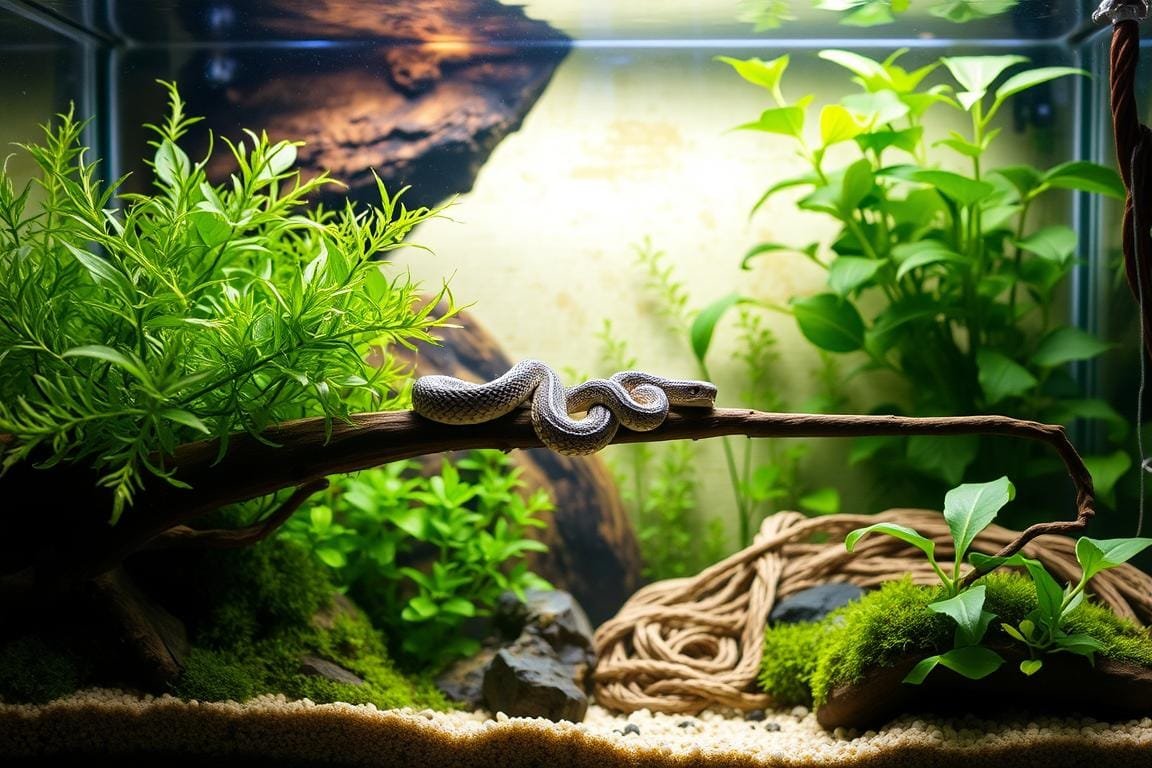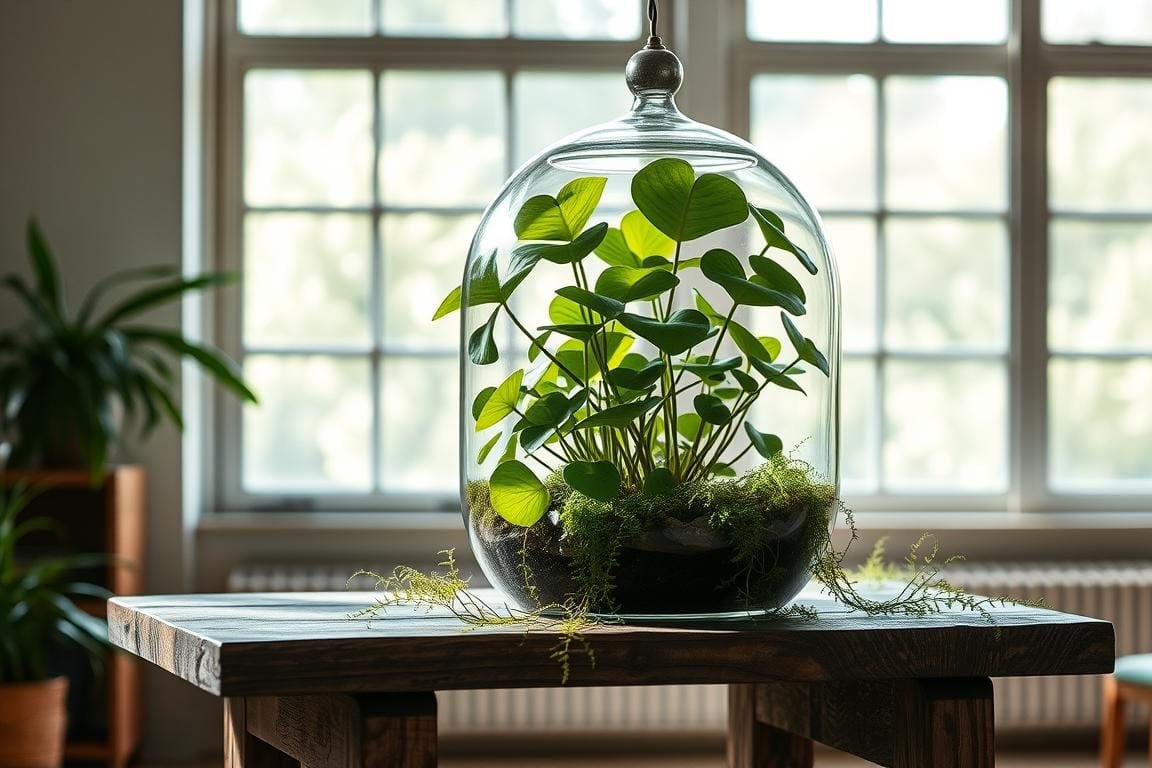Creating a vibrant habitat for small reptiles doesn’t have to be complicated. A dual-environment enclosure blends aquatic and terrestrial zones, offering pets like mourning geckos space to climb, explore, and thrive. This setup mimics their natural ecosystems, balancing beauty and functionality.
Why choose this approach? It supports bioactive elements like live plants and beneficial microbes. These components work together to maintain cleanliness, reducing the need for frequent manual cleaning. Plus, the visual appeal of flowing water and lush greenery transforms your pet’s home into a living art piece.
Expert tips simplify the process. Reptile specialists recommend starting with a waterproof base layer to separate land and water areas. Strategic placement of rocks, driftwood, and moisture-loving plants ensures stability while creating hiding spots. Automated misting systems or shallow pools keep humidity levels ideal.
Ready to dive deeper? This guide breaks down each step—from selecting materials to balancing ecosystems. Whether you’re a beginner or a seasoned hobbyist, you’ll find actionable strategies to craft a habitat that’s as practical as it is stunning.
Understanding Paludariums and Their Unique Appeal
Combining land and water habitats offers more than just visual appeal—it creates dynamic ecosystems. Unlike standard aquariums or terrariums, these dual-environment systems let aquatic and terrestrial life coexist. Vertical designs maximize space, perfect for climbers like tree frogs or small reptiles needing varied terrain.
What Defines This Hybrid Habitat?
A paludarium’s magic lies in its layered structure. The lower water area supports fish or aquatic plants, while elevated land zones host moisture-loving flora and fauna. This setup mimics rainforest streams or marsh edges, providing natural microhabitats. Proper humidity management—often through misters or shallow pools—keeps arboreal species healthy.
Why Mix Water and Land?
Diverse species thrive in these enclosures. Frogs bask near waterfalls, while climbing reptiles explore vines above. The constant moisture reduces stress for humidity-dependent animals. Bioactive elements like moss and springtails naturally break down waste, cutting cleanup time.
Hobbyists love the creative freedom. You can craft cascading waterfalls, floating plants, or hidden caves. Just balance water flow and ventilation to prevent mold. With smart planning, your enclosure becomes a self-regulating slice of nature.
Key Considerations for a Gecko Paludarium Setup
A well-planned enclosure can transform your pet’s quality of life. Proper space allocation ensures climbing zones, hiding spots, and water access coexist without clutter. Start by selecting a vertically oriented tank—aim for at least 18x18x24 inches to give arboreal species room to explore.
Why Choose This Hybrid Design?
Combined land-water systems cater to natural behaviors like basking and foraging. For instance, moisture-loving plants thrive near aquatic areas, while elevated branches support climbing. This setup reduces stress by letting your reptile choose between dry perches or humid microclimates.
Prioritize these steps for success:
- Use a leak-proof tank with secure lids to contain humidity
- Divide the layout into 60% land and 40% water to prevent overcrowding
- Add cork bark or driftwood for vertical exploration
Experts recommend bioactive substrates to support plant growth and waste breakdown. For a detailed walkthrough, explore our tailored setup guide. Remember: balance safety and stimulation—your animal thrives when its environment mirrors wild ecosystems.
Planning the Enclosure: Water Features, Heating, and Humidity
Balancing aquatic and terrestrial elements requires careful planning. Start by dedicating 40% of the enclosure to water features. Use a shallow pool with gentle filtration to mimic natural streams. Submersible pumps paired with sponge filters work best—they prevent debris buildup while keeping water movement subtle.
Establishing the Ideal Water Area
Layer smooth river rocks at the base to create even water distribution. Position driftwood or cork bark to separate land and aquatic zones. For species like mourning geckos, maintain water depth below 2 inches to prevent drowning risks. Weekly partial water changes and live aquatic plants like pothos cuttings help stabilize water quality naturally.
Managing Humidity and Temperature Effectively
Aim for 70-80% humidity levels using automated misters timed for dawn and dusk. Pair this with digital hygrometers to track fluctuations. Heating strategies vary:
| Method | Best For | Temperature Range | Notes |
|---|---|---|---|
| Heat Mats | Land Zones | 75-80°F | Place under substrate |
| Basking Lamps | Dry Perches | 82-85°F | Use timers for day cycles |
| Ceramic Heaters | Night Use | 70-75°F | No light emission |
Select plants like bromeliads or ferns to boost moisture retention. Their broad leaves channel water droplets, creating microclimates. For mourning species, ensure cooler zones stay above 68°F to support activity cycles. Regular checks keep both water and land areas thriving.
Designing the Land Area and Plant Selection

Crafting the perfect land zone starts with smart layering. A balanced substrate mix supports plant roots while preventing waterlogging. Begin with a drainage base of clay pebbles or coarse gravel—this keeps roots healthy and avoids soggy soil.
Selecting the Right Substrate and Drainage Layers
Riverbed sand mixed with coconut fiber works wonders for moisture retention. Top it with sphagnum moss to lock in humidity. This combo creates a bioactive environment where beneficial microbes break down waste naturally.
For sloped areas, add mesh barriers between layers. They stabilize the terrain while letting excess water flow downward. This setup is ideal for species like small frogs that need damp retreats.
Choosing Suitable Plants and Vines for Canopy Coverage
Pothos and creeping fig thrive in humid setups. Their trailing vines create instant canopy coverage across multiple levels. Pair them with bromeliads for color and natural water reservoirs in their leaf bases.
Incorporate cork rounds or hollow logs as hiding spots. These features let shy creatures feel secure while blending into the landscape. Dwarf ferns and nerve plants add texture to lower levels, completing the layered look.
Choose member plants like spiderwort or philodendron that adapt to varying light conditions. Their diverse growth habits sustain a self-cleaning ecosystem. This approach reduces maintenance while offering frogs and climbing species endless exploration opportunities.
Integrating a Bioactive Clean-Up Crew and Support Systems
A thriving ecosystem relies on unseen helpers working behind the scenes. Tiny invertebrates like springtails and dwarf isopods act as nature’s cleanup crew, breaking down fallen leaves and organic waste. This natural process keeps enclosures fresh while reducing manual maintenance.
Utilizing Invertebrates to Maintain Cleanliness
Choose species that match your habitat’s needs. Springtails excel at consuming mold and decaying plant matter, while shrimp manage algae in water zones. Avoid large species that might disturb your pet—opt for smaller varieties like tropical springtails or powder blue isopods.
Creating a Self-Sustaining Ecosystem
The careful addition of aquatic life enhances balance. Small fish like chili rasboras or endlers add movement without overcrowding water areas. Always research compatibility—some species might nibble on delicate plants or stress climbing inhabitants.
| Species | Role | Habitat Zone | Notes |
|---|---|---|---|
| Springtails | Waste breakdown | Land/Leaf litter | Thrive in moist substrates |
| Neocaridina Shrimp | Algae control | Water | Need stable pH levels |
| Dwarf Isopods | Detritus removal | Soil surface | Avoid dry areas |
Enhance vertical spaces with climbing-friendly structures. Cork tubes or resin vines let arboreal species explore while hiding cleanup crews below. This layered approach addresses common questions about space optimization and species coexistence.
Pro tip: Introduce invertebrates 2-3 weeks before adding your pet. This gives them time to establish colonies and start processing waste naturally. Regular monitoring ensures every addition supports the habitat’s long-term health.
Setting Up Safe and Engaging Enclosures for Reptiles and Amphibians

Building a habitat that keeps creatures healthy starts with smart environmental design. Temperature control, lighting, and physical structures work together to mimic natural behaviors. Let’s explore how to balance these elements for an enriching experience.
Optimizing Temperature and Lighting for Varied Species
Different species need distinct thermal zones. For example, bearded dragons require basking spots up to 95°F, while tree frogs thrive at 75-85°F. Use gradient heating to let animals self-regulate—place heat lamps at one end and cooler hides at the other.
Lighting matters too. UVB bulbs support calcium absorption for diurnal lizards, while nocturnal species prefer low-level moonlight LEDs. Timers automate day-night cycles, reducing stress.
| Light Type | Purpose | Best For |
|---|---|---|
| UVB 5.0 | Calcium synthesis | Desert species |
| Full Spectrum | Plant growth | Live-plant setups |
| Moonlight LED | Night viewing | Nocturnal frogs |
Designing Hiding Spots and Climbing Areas
Vertical space is key. Attach cork bark slabs to walls for climbing, or add artificial trees with sturdy branches. Horizontal elements like flat stones create basking zones near the floor.
Layer hides at multiple heights: caves under driftwood for ground-dwellers, elevated foliage pockets for climbers. This way of structuring space lets all inhabitants feel secure while exploring.
Mix textures for grip—vine-wrapped poles or rough rocks prevent slips. One zoo-inspired setup uses stacked slate to create a cascading floor design, encouraging natural movement patterns.
Testing and Fine-Tuning Your Paludarium Environment
Your habitat’s success hinges on methodical testing before introducing life. Rushing this part often leads to unstable conditions. Take time to verify every system—water quality, lighting, and airflow—work in harmony. This prevents costly changes later and ensures a smooth transition for future inhabitants.
Water Quality, Equipment Checks, and Plant Acclimation
Start by testing the aquarium zone daily for a week. Use liquid test kits to monitor ammonia, nitrates, and pH levels. Ideal ranges vary, but most setups aim for:
| Parameter | Target Range | Adjustment Tip |
|---|---|---|
| pH | 6.5–7.5 | Add driftwood to lower |
| Ammonia | 0 ppm | Boost beneficial bacteria |
| Nitrates | Add floating plants |
Run equipment like filters and heaters for 48 hours straight. Check for leaks or inconsistent temperatures. Acclimate plants during this phase—place them in the setup to root while you monitor light intensity on each side.
Step-by-Step Testing Before Introducing Inhabitants
Follow this 5-day protocol:
- Day 1-2: Test water chemistry morning/night
- Day 3: Verify humidity stays above 70% without manual misting
- Day 4: Inspect plant health—yellow leaves signal lighting changes
- Day 5: Do a final equipment check
Adjustments are normal. If one side dries faster, reposition misters or add a shallow water dish. Remember: Patience isn’t just about luck—it’s a critical part of creating a stable ecosystem. Once all parameters hold steady for three days, your aquarium-land hybrid is ready for life!
Final Thoughts: Building a Living Habitat That Evolves
Creating a dynamic ecosystem for small climbers is an ongoing journey. Start with a solid foundation—proper layout division, humidity control, and bioactive support systems. These steps set the stage for a habitat that thrives while minimizing daily upkeep.
Over time, your enclosure will grow and shift. Plants spread, branches weather, and microclimates change. Keep a watchful eye on structural stability, especially where wood meets water. Gentle adjustments prevent bigger issues like mold or uneven wear.
Stay curious as your skills develop. Swap out plants for better growth, reposition climbing branches, or tweak misting schedules. Each small improvement deepens your understanding of the ecosystem’s balance.
Thanks for joining this creative adventure! Your dedication to refining the setup ensures inhabitants flourish. Remember—every thriving leaf and active creature proves your habitat’s success. Keep experimenting, stay observant, and enjoy watching your living masterpiece evolve.





